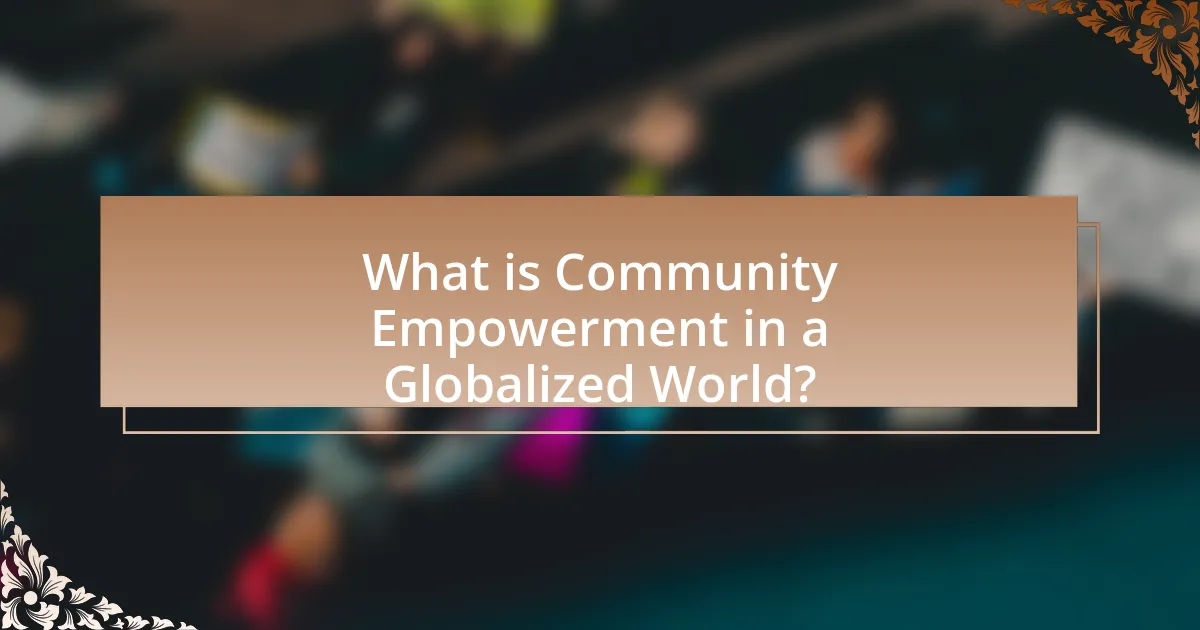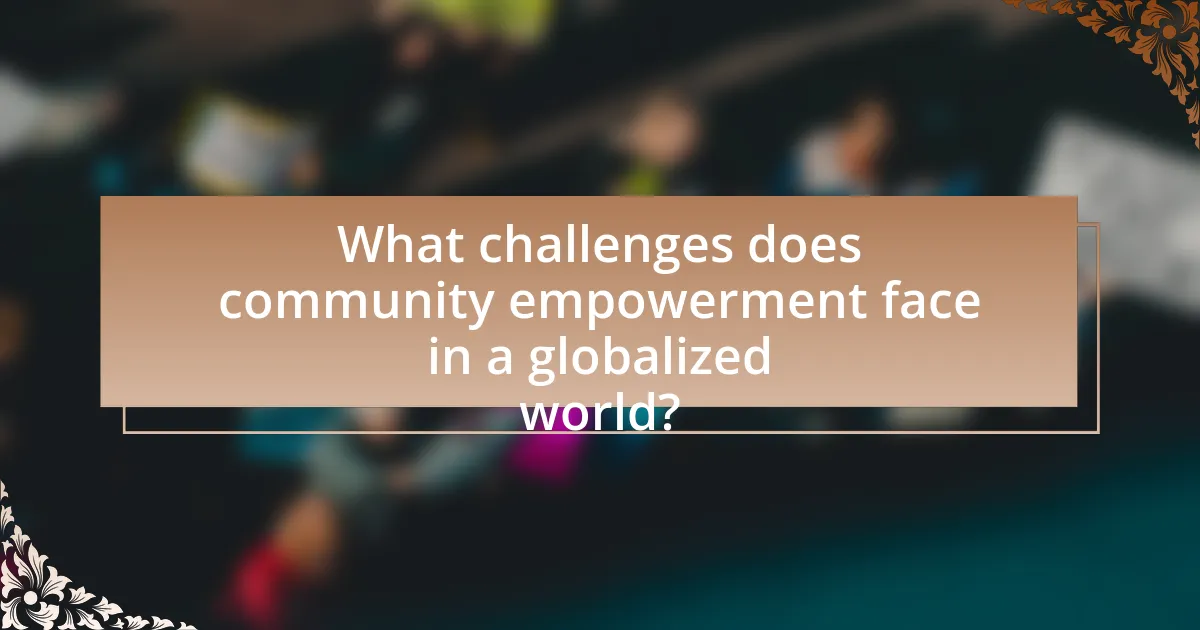Community empowerment in a globalized world is the process through which communities gain the ability to influence decisions affecting their lives amidst global economic, social, and political changes. The article explores how globalization facilitates community empowerment through access to resources, information, and networks, while also addressing key factors such as economic integration, cultural exchange, and technological advancement. It highlights the importance of community empowerment for social justice and economic development, examines current trends and challenges, and discusses the role of local organizations and grassroots movements in enhancing community resilience. Additionally, the article outlines best practices for mobilizing resources and the critical role of education in fostering empowerment within communities.

What is Community Empowerment in a Globalized World?
Community empowerment in a globalized world refers to the process through which communities gain the ability to influence decisions that affect their lives, particularly in the context of global economic, social, and political changes. This empowerment is facilitated by access to information, resources, and networks that transcend local boundaries, enabling communities to advocate for their rights and needs on a larger scale. For instance, the rise of digital communication tools allows marginalized groups to connect with global movements, enhancing their capacity to mobilize support and share their experiences. Research indicates that empowered communities are more resilient and better equipped to address challenges posed by globalization, such as economic inequality and cultural homogenization, thereby fostering sustainable development and social justice.
How does globalization influence community empowerment?
Globalization influences community empowerment by facilitating access to resources, information, and networks that enhance local capacities. Through global interconnectedness, communities can share knowledge and best practices, leading to improved governance and social cohesion. For instance, the rise of digital platforms enables grassroots movements to mobilize support and advocate for local issues on a global scale, as seen in the Arab Spring where social media played a crucial role in community organization and empowerment. Additionally, economic globalization can provide communities with opportunities for trade and investment, which can lead to increased local development and self-sufficiency.
What are the key factors of globalization affecting communities?
The key factors of globalization affecting communities include economic integration, cultural exchange, technological advancement, and political collaboration. Economic integration leads to increased trade and investment, which can enhance local economies but may also result in job displacement. Cultural exchange fosters diversity and innovation, yet it can challenge traditional values and practices. Technological advancement facilitates communication and access to information, empowering communities but also widening the digital divide. Political collaboration among nations can promote shared governance and policy-making, impacting local autonomy and identity. These factors collectively shape the dynamics of community empowerment in a globalized context.
How do cultural exchanges impact community empowerment?
Cultural exchanges significantly enhance community empowerment by fostering mutual understanding and collaboration among diverse groups. These exchanges facilitate the sharing of knowledge, skills, and cultural practices, which can lead to increased social cohesion and collective action within communities. For instance, programs like the Fulbright Program have demonstrated that international educational exchanges not only broaden participants’ perspectives but also enable them to bring back valuable insights and resources to their home communities, thereby strengthening local capacities. Additionally, research from the International Journal of Cultural Policy indicates that communities engaged in cultural exchanges often experience improved economic opportunities and social networks, further empowering them to advocate for their needs and interests.
Why is community empowerment important in today’s society?
Community empowerment is important in today’s society because it fosters social cohesion and enhances the capacity of individuals to influence decisions that affect their lives. Empowered communities are better equipped to address local issues, advocate for their needs, and participate in democratic processes. Research indicates that communities with higher levels of empowerment experience improved health outcomes, economic development, and reduced crime rates, as evidenced by a study published in the Journal of Community Psychology, which found that community-driven initiatives led to a 30% increase in local engagement and a significant decrease in social isolation. This demonstrates that community empowerment not only strengthens individual agency but also contributes to the overall resilience and sustainability of society.
What role does community empowerment play in social justice?
Community empowerment is essential for achieving social justice as it enables marginalized groups to gain control over their lives and advocate for their rights. By fostering collective action and enhancing the capacity of individuals within a community, empowerment leads to increased participation in decision-making processes that affect their lives. For instance, research by the United Nations Development Programme highlights that empowered communities are more likely to challenge systemic inequalities and demand equitable access to resources and opportunities. This active engagement not only promotes social equity but also strengthens democratic governance, as empowered individuals are better equipped to hold authorities accountable.
How does community empowerment contribute to economic development?
Community empowerment significantly contributes to economic development by enhancing local decision-making and resource management. When communities are empowered, they gain the ability to identify their own needs and priorities, leading to more effective allocation of resources and initiatives that directly address local challenges. For instance, empowered communities often engage in collective action, which can result in the establishment of local businesses and cooperatives, fostering job creation and economic resilience. Research by the World Bank indicates that community-driven development projects can increase local incomes by up to 30%, demonstrating a clear link between empowerment and economic growth.

What are the current trends in community empowerment?
Current trends in community empowerment include increased digital engagement, participatory governance, and a focus on social equity. Digital engagement allows communities to leverage technology for organizing, advocacy, and resource sharing, exemplified by platforms like social media that facilitate grassroots movements. Participatory governance trends emphasize involving community members in decision-making processes, as seen in initiatives like participatory budgeting, which has been implemented in cities worldwide, enhancing transparency and accountability. Additionally, the focus on social equity addresses systemic inequalities, with organizations and movements advocating for marginalized voices, supported by data indicating that inclusive policies lead to stronger community resilience and cohesion.
How are technology and social media shaping community empowerment?
Technology and social media are significantly shaping community empowerment by providing platforms for communication, collaboration, and resource sharing. These tools enable individuals and groups to organize, advocate for their needs, and mobilize support more effectively than ever before. For instance, social media campaigns have successfully raised awareness and funds for various social issues, exemplified by movements like #BlackLivesMatter, which utilized Twitter and Facebook to galvanize community action and influence policy changes. Additionally, technology facilitates access to information and educational resources, empowering marginalized communities to engage in civic activities and decision-making processes. According to a report by the Pew Research Center, 69% of adults in the U.S. use social media, highlighting its role as a vital communication tool that fosters community engagement and empowerment.
What tools are communities using to enhance empowerment through technology?
Communities are using digital platforms, mobile applications, and social media to enhance empowerment through technology. Digital platforms like Facebook Groups and Slack facilitate communication and collaboration among community members, enabling them to share resources and support each other. Mobile applications such as Nextdoor connect neighbors, fostering local engagement and problem-solving. Social media serves as a powerful tool for advocacy, allowing communities to raise awareness and mobilize support for various causes. These tools collectively enhance community empowerment by providing accessible means for information sharing, networking, and collective action.
How does social media facilitate community engagement?
Social media facilitates community engagement by providing platforms for interaction, information sharing, and collective action among community members. These platforms enable users to connect with others who share similar interests, fostering a sense of belonging and community identity. For instance, studies show that 69% of adults in the U.S. use social media, which allows them to participate in discussions, organize events, and mobilize support for local causes. Additionally, social media tools like Facebook Groups and Twitter hashtags create spaces for dialogue and collaboration, enhancing community cohesion and responsiveness to local issues.
What role do local organizations play in community empowerment?
Local organizations play a crucial role in community empowerment by fostering social cohesion, providing resources, and facilitating participation in decision-making processes. These organizations often serve as a bridge between community members and external entities, ensuring that local voices are heard and represented. For instance, studies have shown that communities with active local organizations experience higher levels of civic engagement and improved access to services, which enhances overall community well-being. Additionally, local organizations often mobilize resources and support networks that enable individuals to develop skills and capacities, further empowering them to advocate for their needs and interests.
How do grassroots movements contribute to community empowerment?
Grassroots movements contribute to community empowerment by fostering local leadership and encouraging collective action among community members. These movements often arise from the needs and concerns of individuals within a community, enabling them to organize, advocate for their rights, and influence decision-making processes. For instance, the Civil Rights Movement in the United States, which was driven by grassroots efforts, led to significant legislative changes that enhanced the rights and empowerment of marginalized communities. Additionally, grassroots movements often provide education and resources, equipping individuals with the skills necessary to advocate for themselves and their communities, thereby reinforcing their agency and capacity for self-determination.
What partnerships are essential for effective community empowerment?
Effective community empowerment relies on partnerships between local governments, non-profit organizations, and community-based groups. These partnerships facilitate resource sharing, enhance local capacity, and promote inclusive decision-making processes. For instance, research by the World Bank highlights that collaborative efforts between local authorities and civil society organizations lead to improved service delivery and increased community engagement. Such partnerships are essential for fostering trust, ensuring accountability, and mobilizing resources effectively, ultimately driving sustainable community development.

What challenges does community empowerment face in a globalized world?
Community empowerment faces significant challenges in a globalized world, primarily due to economic disparities, cultural homogenization, and political marginalization. Economic disparities arise as globalization often benefits wealthier nations and corporations, leaving local communities with limited resources and opportunities for self-determination. Cultural homogenization threatens local identities and traditions, as global media and consumer culture promote a singular worldview, undermining community cohesion. Political marginalization occurs when local voices are overshadowed by global agendas, making it difficult for communities to influence decisions that affect their lives. These challenges hinder the ability of communities to effectively mobilize, advocate for their needs, and sustain their unique cultural identities in an increasingly interconnected world.
How do economic disparities affect community empowerment?
Economic disparities significantly hinder community empowerment by limiting access to resources, education, and opportunities. Communities facing economic challenges often struggle to mobilize effectively, as financial constraints restrict their ability to organize, advocate for their needs, and implement sustainable development initiatives. For instance, a study by the Pew Research Center found that lower-income communities experience reduced civic engagement, which directly correlates with diminished political influence and representation. This lack of engagement perpetuates a cycle of disenfranchisement, making it difficult for these communities to achieve meaningful change and empowerment.
What are the barriers to access for marginalized communities?
Barriers to access for marginalized communities include economic inequality, systemic discrimination, and lack of representation. Economic inequality restricts access to essential resources such as education, healthcare, and employment opportunities, which are crucial for community empowerment. Systemic discrimination, often rooted in historical injustices, perpetuates social exclusion and limits participation in decision-making processes. Additionally, lack of representation in political and social institutions further marginalizes these communities, making it difficult for them to advocate for their needs and rights. According to the World Bank, marginalized groups often face a higher risk of poverty and social exclusion, highlighting the urgent need for targeted interventions to address these barriers.
How does political instability impact community initiatives?
Political instability significantly undermines community initiatives by disrupting social cohesion and resource allocation. When political environments are unstable, communities often face challenges such as reduced funding, increased violence, and a lack of trust in local governance. For instance, a study by the World Bank indicates that regions experiencing political turmoil see a 30% decrease in community project funding, which directly affects the implementation and sustainability of local initiatives. Additionally, instability can lead to a diversion of attention and resources away from community development towards immediate security concerns, further stalling progress.
What are the implications of cultural homogenization on community empowerment?
Cultural homogenization negatively impacts community empowerment by eroding local identities and diminishing the unique cultural practices that foster community cohesion. As global cultures, often driven by dominant media and economic forces, spread, local traditions and languages may decline, leading to a loss of cultural diversity. This loss can weaken community bonds and reduce the capacity for collective action, as shared cultural narratives are essential for mobilizing individuals toward common goals. Research indicates that communities with strong cultural identities are more resilient and better able to advocate for their needs, suggesting that cultural homogenization undermines these essential characteristics. For instance, a study by the United Nations Educational, Scientific and Cultural Organization (UNESCO) highlights that communities with preserved cultural heritage demonstrate higher levels of social cohesion and empowerment.
How can communities preserve their identity while engaging globally?
Communities can preserve their identity while engaging globally by actively promoting and integrating their cultural practices, languages, and traditions into global dialogues. This approach allows communities to maintain their unique characteristics while participating in broader conversations. For instance, the United Nations Educational, Scientific and Cultural Organization (UNESCO) emphasizes the importance of cultural heritage in fostering identity, stating that cultural diversity is essential for sustainable development. By leveraging platforms that celebrate local customs and narratives, communities can ensure their voices are heard and respected on the global stage, thus reinforcing their identity amidst globalization.
What strategies can be employed to combat cultural erosion?
To combat cultural erosion, communities can implement strategies such as promoting local languages, preserving traditional practices, and fostering cultural education. Promoting local languages helps maintain cultural identity, as evidenced by UNESCO’s recognition of language preservation as vital for cultural diversity. Preserving traditional practices, such as festivals and crafts, reinforces community bonds and cultural heritage, which studies show can enhance social cohesion. Additionally, fostering cultural education through schools and community programs ensures that younger generations understand and appreciate their cultural roots, as highlighted by research from the National Endowment for the Arts, which found that cultural education increases community engagement and pride.
What best practices can enhance community empowerment?
Best practices that can enhance community empowerment include fostering inclusive participation, building local leadership, and providing access to resources and education. Inclusive participation ensures that all community members have a voice in decision-making processes, which has been shown to increase engagement and ownership of community initiatives. Building local leadership develops skills and confidence among residents, enabling them to advocate for their needs effectively. Access to resources and education equips individuals with the knowledge and tools necessary to improve their circumstances, leading to sustainable community development. Research indicates that communities with strong local leadership and active participation experience greater social cohesion and resilience, as evidenced by studies conducted by the World Bank on community-driven development initiatives.
How can communities effectively mobilize resources for empowerment?
Communities can effectively mobilize resources for empowerment by establishing strong networks and partnerships that leverage local assets and external support. These networks facilitate collaboration among community members, organizations, and stakeholders, enabling the pooling of financial, human, and informational resources. For instance, successful initiatives often involve local governments, non-profits, and businesses working together to create programs that address specific community needs, such as education, health, or economic development. Research shows that communities with robust social capital are more likely to mobilize resources effectively, as evidenced by the Community Development Block Grant program, which has empowered numerous localities in the United States to enhance their economic conditions through collaborative resource management.
What role does education play in fostering community empowerment?
Education plays a crucial role in fostering community empowerment by equipping individuals with the knowledge and skills necessary to advocate for their rights and improve their socio-economic conditions. Through education, community members gain critical thinking abilities, enabling them to identify issues affecting their lives and mobilize resources effectively. For instance, studies show that higher education levels correlate with increased civic participation, as educated individuals are more likely to engage in community decision-making processes. Furthermore, educational programs that focus on social justice and leadership development empower individuals to challenge systemic inequalities, thereby fostering a more equitable community environment.










